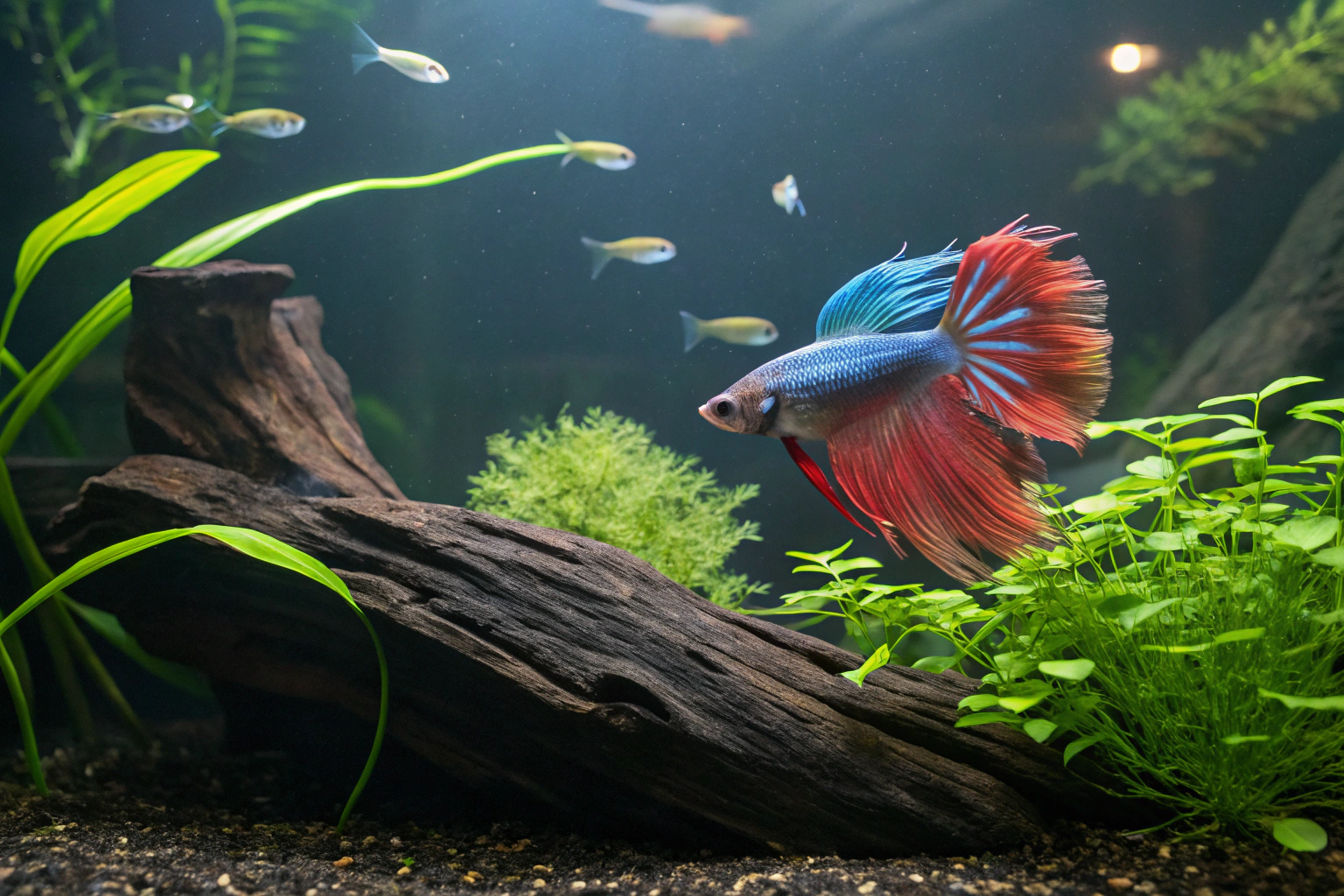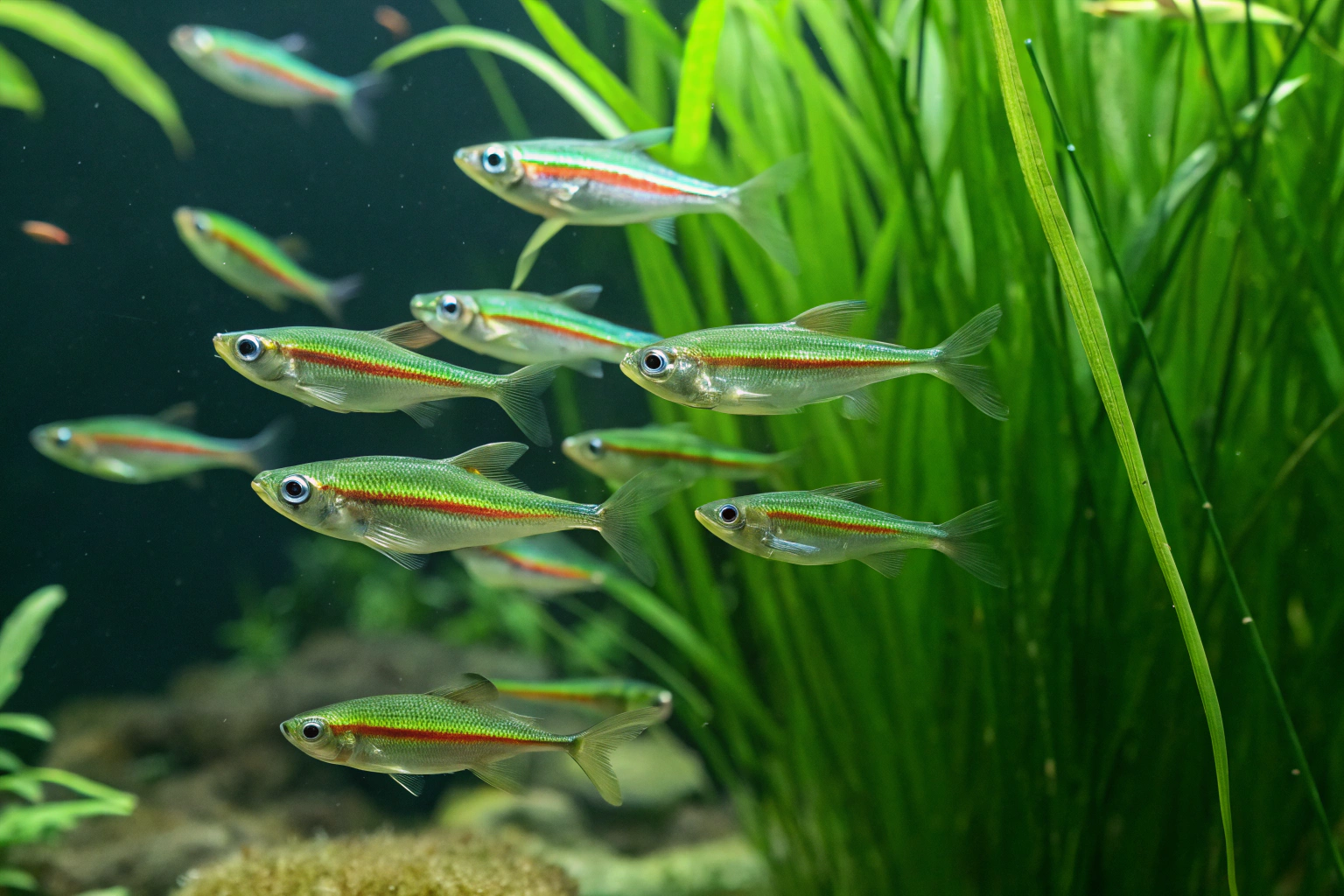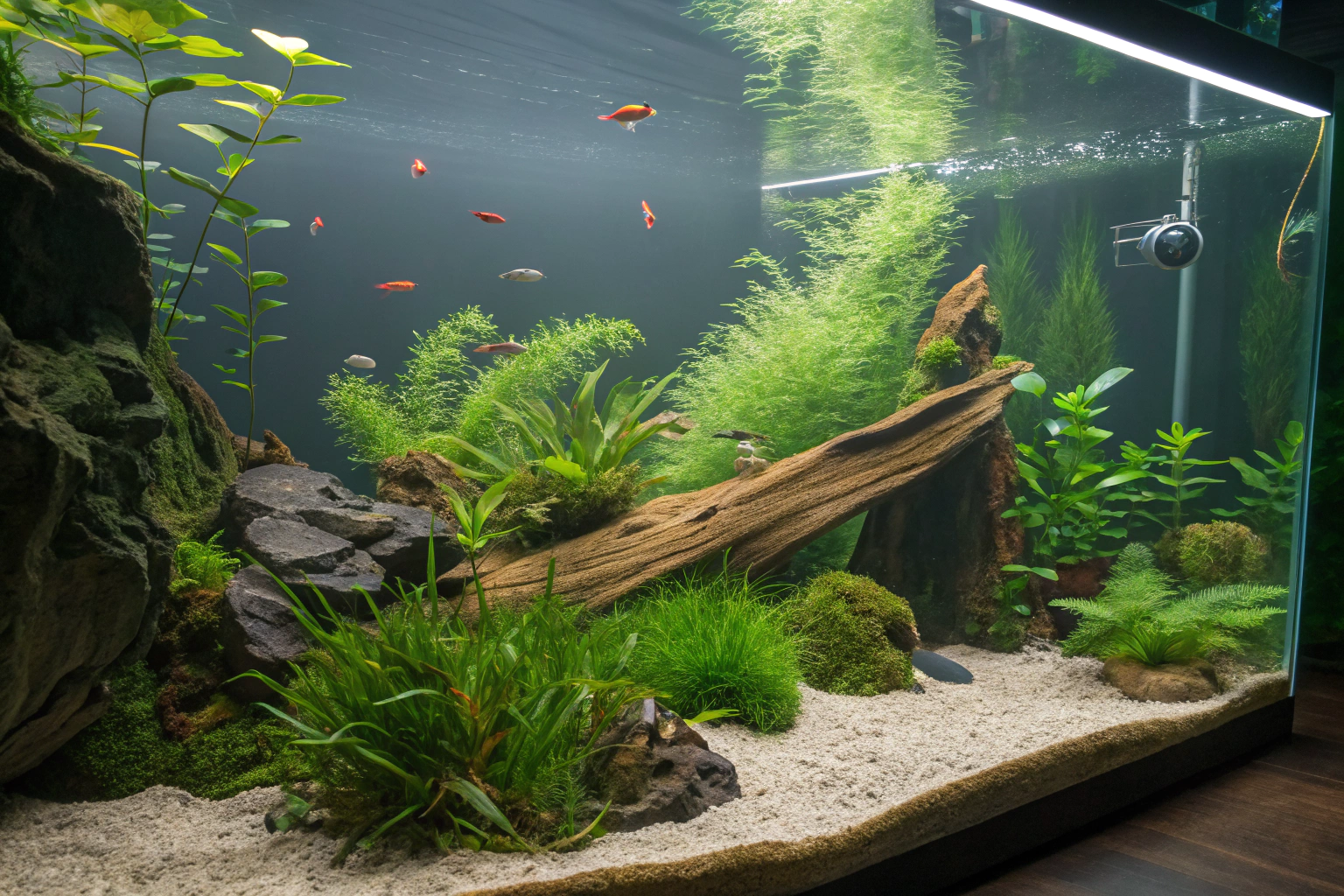Can Green Neon Tetra Fish Live with Bettas Without Fighting?
This post may contain affiliate links.
The vibrant allure of Betta fish, with their flowing fins and striking colors, often leads aquarists to ponder the possibilities of community tanks. Similarly, the subtle shimmer and peaceful schooling nature of Green Neon Tetras (Paracheirodon simulans) make them a popular choice. A common question arises: can these two captivating species coexist peacefully in the same aquarium? Specifically, can Green Neon Tetras live with Bettas without the infamous aggression Bettas are known for? This question delves into the heart of fish compatibility, requiring a careful examination of the temperaments, environmental needs, and potential risks associated with housing these species together. While the image of a colorful Betta gliding amongst a school of shimmering Green Neons is appealing, achieving harmony requires careful planning and understanding of each fish’s unique characteristics and requirements. This article explores the complexities of keeping Green Neon Tetras and Bettas together, analyzing the factors that contribute to success or failure, and providing guidance for aquarists considering this combination.

Understanding the Betta: More Than Just a Pretty Face
Betta splendens, often called Siamese Fighting Fish, carry a reputation steeped in territorial aggression. This isn’t merely anecdotal; centuries of selective breeding in Thailand were focused on enhancing this fighting instinct for sport. While modern, captive-bred Bettas might display a range of personalities, this inherent territorial nature remains a core aspect of their behavior, particularly in males. A male Betta typically views his entire tank as his domain and will often react aggressively towards any perceived intruders, especially other fish with bright colors or long, flowing fins that might be mistaken for rival males. This aggression isn’t universal in its intensity – some Bettas are relatively placid, while others will relentlessly harass tank mates. However, the potential for conflict is always present. Female Bettas are generally less aggressive than males but can still exhibit territorial behavior, especially towards other females unless kept in a carefully managed ‘sorority’ tank (which requires specific conditions and a larger space). Understanding this deep-seated territorial drive is fundamental when considering any tank mates for a Betta, as their peace often depends on the companions being unobtrusive, non-threatening, and having ample space to avoid confrontation.
The Green Neon Tetra: A Subtle Schooling Fish
Green Neon Tetras (Paracheirodon simulans) are often confused with their more common cousins, the standard Neon Tetra (Paracheirodon innesi), but they possess distinct characteristics. Green Neons are generally smaller, reaching about 1-1.5 inches, and their signature iridescent stripe is typically greener and runs more completely along their body length compared to the blue and shorter red stripe of the standard Neon. Crucially, Green Neon Tetras are peaceful, shoaling fish. This means they thrive in groups and feel more secure when kept in schools of six or more, ideally ten or more in larger tanks. This schooling behavior is not just for aesthetics; it’s vital for their well-being, reducing stress and encouraging natural behaviors. When kept in insufficient numbers, they can become timid, stressed, and potentially more prone to nipping fins out of anxiety, although they are not typically considered aggressive fin nippers like some other tetra species. Their small size, generally subdued coloration (compared to fancy guppies or even standard neons), and fast-swimming nature can sometimes make them less likely to trigger a Betta’s aggression compared to larger, flashier, or slower-moving fish. However, their quick movements could also potentially stress a calmer Betta, highlighting the need for careful consideration of individual fish personalities.
Factors Influencing Compatibility: It’s Not Black and White
The question of whether Green Neon Tetras and Bettas can live together doesn’t have a simple yes or no answer. Success hinges on a delicate balance of several critical factors, primarily revolving around the environment provided and the individual personalities of the fish involved. Perhaps the most crucial factor is tank size. While a single Betta might manage in a 5-gallon tank, adding a school of active Green Neon Tetras demands significantly more space. Experts often recommend a minimum of 10 gallons, but 15-20 gallons or larger is strongly advised to provide adequate swimming room for the tetras and allow the Betta sufficient personal territory, thereby reducing potential conflict. As noted by aquarium resources like Bettafish.org, adequate space is essential not just for territory but also to manage the increased bioload from multiple fish, necessitating a robust filtration system.
Beyond sheer volume, the tank’s setup plays a vital role. A sparsely decorated tank offers few places for tetras to retreat or for the Betta to feel secure in its territory, increasing the likelihood of stressful encounters. A densely planted aquarium, incorporating both tall background plants and foreground cover like driftwood, caves, or rock formations, is essential. These elements break lines of sight, create distinct zones, and provide crucial hiding places for the tetras should the Betta become aggressive. This mimics their natural environments and helps reduce stress for both species.
The number of Green Neon Tetras is also paramount. Keeping them in a proper school (at least 6-8, preferably 10+) is non-negotiable. A larger school distributes any potential aggression from the Betta, preventing one individual from being singled out and harassed. Furthermore, schooling helps the tetras feel secure, reducing stress-induced behaviors like potential fin nipping, a concern highlighted by sources such as Aqueon when discussing tetra behavior in smaller groups. Finally, the unpredictable element of individual fish personality cannot be overstated. Some Bettas are inherently more aggressive and may never tolerate tank mates, regardless of tank size or setup. Conversely, some Green Neon Tetras might be unusually bold. Careful observation after introduction is key, always having a backup tank ready to separate the fish immediately if persistent aggression or stress occurs.

Potential Risks: When Cohabitation Goes Wrong
Despite the potential for success under ideal conditions, housing Green Neon Tetras with Bettas is not without significant risks. The primary concern is the Betta’s aggression. Even with ample space and hiding spots, a particularly territorial Betta might still perceive the fast-moving tetras as a threat or annoyance, leading to chasing, flaring, and potentially lethal attacks. While Green Neons are fast, a persistent Betta can inflict serious injury or cause chronic stress. Stress, even without direct physical harm, is a major risk factor for both species. Constant vigilance or harassment from the Betta can weaken the tetras’ immune systems, making them susceptible to diseases. Conversely, the constant activity of a large tetra school could potentially stress a more timid Betta, although this is generally less common than Betta-on-tetra aggression. Fin nipping is another potential issue, though perhaps less likely with Green Neons compared to other tetras if kept in a sufficiently large school. However, stressed tetras, or those kept in inadequate numbers, might resort to nipping the Betta’s long, flowing fins, leading to injury, infection, and stress for the Betta. It’s crucial to remember that even if things seem peaceful initially, dynamics can change, especially as fish mature or if environmental conditions shift. Constant monitoring, particularly during the initial introduction phase (which can last days or weeks), is essential to mitigate these risks, and separation must be immediate if signs of trouble arise.

Making it Work: Recommendations for Cohabitation
If, after understanding the risks and requirements, you decide to attempt housing Green Neon Tetras with a Betta, meticulous planning and execution are paramount. Success is never guaranteed, but following best practices significantly increases the chances of a peaceful coexistence. First, select the largest possible tank; a minimum of 15-20 gallons is highly recommended to provide ample space for both the Betta’s territory and the tetras’ swimming needs. Second, heavily plant the aquarium using a variety of live or silk plants, driftwood, and caves to create visual barriers and numerous hiding spots. This aquascaping is crucial for reducing stress and aggression. Third, introduce the Green Neon Tetras first, allowing them to establish themselves in the tank for a week or two before adding the Betta. This allows the tetras to feel more comfortable and less like intruders when the Betta arrives. Fourth, ensure you have a sufficiently large school of Green Neon Tetras – aim for at least 8-10 individuals. This helps diffuse potential aggression and promotes natural schooling behavior. Fifth, choose your Betta carefully if possible; opt for one known to have a calmer temperament, perhaps a female or a male with shorter fins (like a Plakat), though personality varies greatly even within types. Avoid Bettas known to be highly aggressive. Sixth, have a backup plan. A separate, cycled quarantine or hospital tank must be ready at a moment’s notice to house either the Betta or the tetras if conflict arises. Finally, monitor interactions closely, especially during the first few days and weeks. Watch for signs of persistent chasing, flaring, nipping, or stress (like clamped fins, hiding, or loss of appetite) in either species. Be prepared to separate them permanently if necessary for their health and well-being.
Considering Alternatives: Safer Bets for Betta Tanks
Given the inherent risks and specific requirements for successfully keeping Green Neon Tetras with Bettas, some aquarists may prefer less challenging tank mates. Fortunately, several other species are generally considered more compatible and less likely to provoke a Betta’s aggression or suffer from it. Bottom-dwelling fish like Corydoras catfish (especially smaller varieties like Pygmy Cories) are often recommended, as they occupy a different tank level and are typically peaceful scavengers. As mentioned in resources like Aqueon’s guide, Corydoras do best in small groups. Similarly, Kuhli Loaches, with their nocturnal habits and burrowing nature, tend to stay out of the Betta’s way. Certain Rasboras, such as Harlequin or Chili Rasboras, are often cited as good options due to their peaceful temperament and schooling nature, provided the tank is large enough (10+ gallons). For non-fish companions, invertebrates like Mystery Snails or various types of shrimp (like Amano or Ghost Shrimp, though shrimp can sometimes become Betta snacks) are popular choices, as detailed by sources like Bettafish.org. These alternatives often present fewer compatibility challenges while still adding life and interest to a Betta aquarium.

Conclusion: A Calculated Risk
In conclusion, the question of whether Green Neon Tetras can live peacefully with Betta fish is complex, lacking a definitive yes or no. While cohabitation is achievable under specific, carefully managed conditions, it remains a calculated risk. Success hinges primarily on providing a spacious environment (15-20 gallons minimum), a densely decorated tank offering ample hiding places, maintaining the tetras in a sufficiently large school (8-10+), and, crucially, the individual temperaments of the fish involved. Even with meticulous planning, the inherent territorial nature of Bettas means aggression is always a possibility, necessitating constant vigilance and a readily available backup plan. Aquarists must weigh the potential beauty of this pairing against the significant risks of stress, injury, or death for the fish. For those seeking lower-risk companions, exploring alternatives like Corydoras catfish, Kuhli loaches, or certain Rasboras might be a more prudent choice. Ultimately, prioritizing the health and well-being of the fish above aesthetic desires is paramount when deciding whether to attempt this challenging but potentially rewarding combination.
References
- Aqueon. “What Fish Can Live With Bettas?” Aqueon Articles. Accessed June 3, 2025. https://www.aqueon.com/articles/what-fish-can-live-with-bettas
- Bettafish.org. “10 Safe Betta Fish Tank Mates & Companions.” Bettafish.org. Last Updated February 23, 2024. Accessed June 3, 2025. https://bettafish.org/betta-fish-tank-mates/
